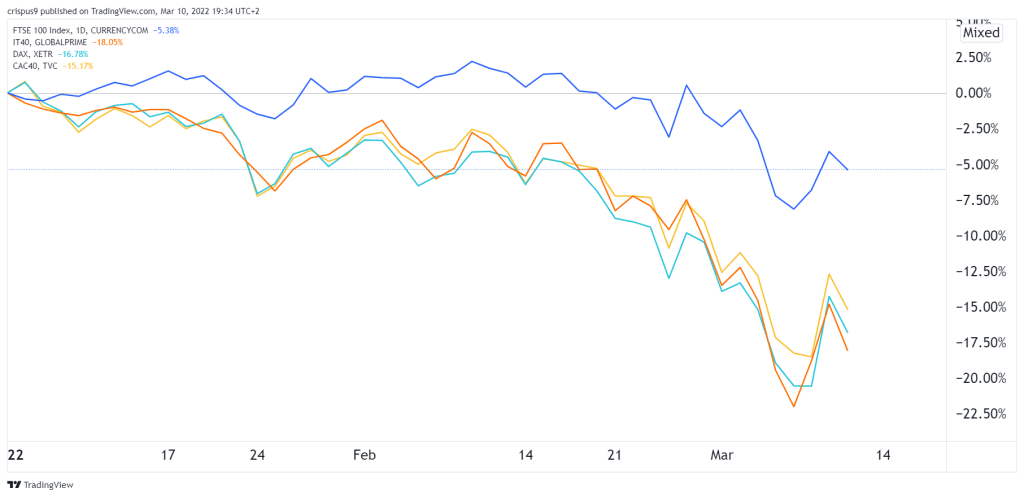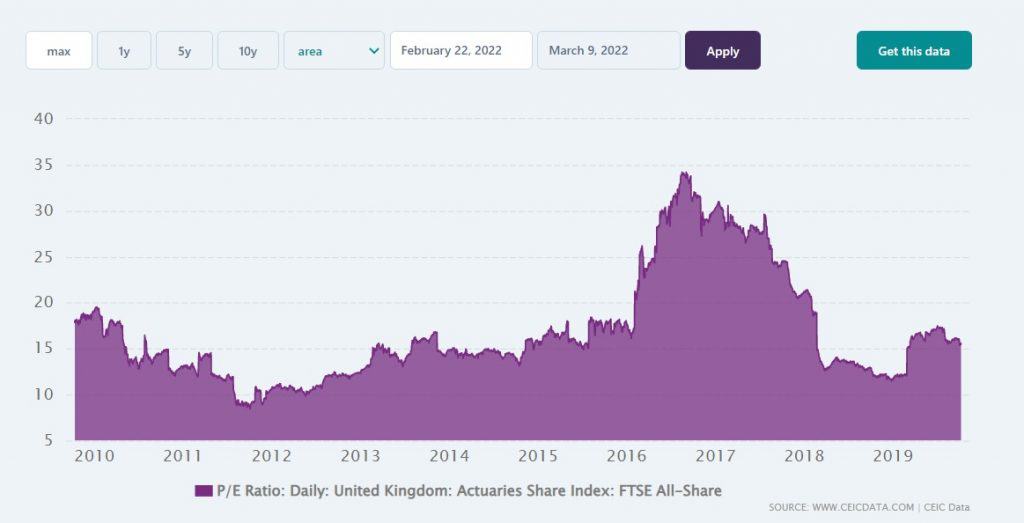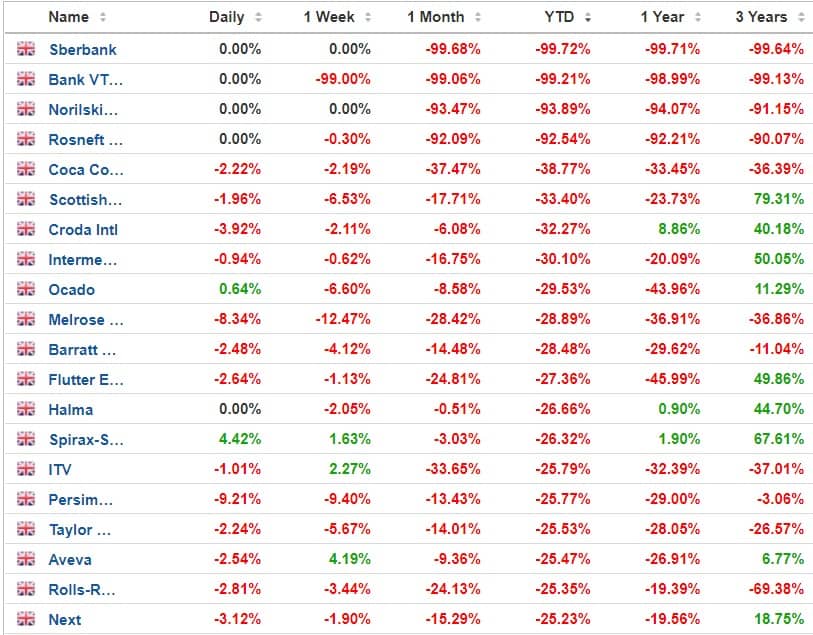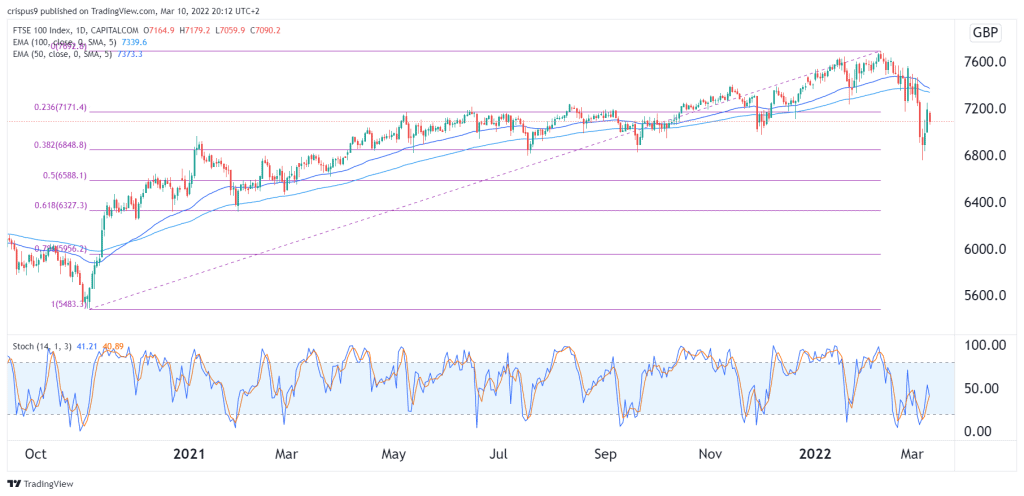- What is the outlook of the FTSE 100 index in 2022? We highlight the best and worst performers and what to expect in the near term.
The FTSE 100 index has been under intense pressure in 2022 as the crisis in Ukraine escalates. After soaring to a multi-year high of £7,683, the stock has moved into correction territory and fallen by about 10%. It is trading at £7,088 while most of its companies are in the red year-to-date. Still, it has done better than other European indices like CAC 40 of France, DAX index of Germany, and FTSE MIB of Italy.
Footsie crash explained
There are several reasons why the FTSE 100 index has dropped sharply in the past few months. First, the Bank of England (BOE) has had a role to play. The bank surprised investors in November when it decided to hike interest rates. It then followed it up with another hike in February and hinted that it will deliver further hikes this year.
The BOE argued that rate hikes were necessary, considering that the economy saw a surge in inflation while the labour market tightened. Still, despite the two rate hikes, UK’s inflation remains at elevated levels. Historically, indices like the FTSE tend to underperform in a period of high-interest rates.
Second, the FTSE 100 index has crashed because of the ongoing crisis in Ukraine. The Boris Johnson administration has announced new sanctions on Russian oligarchs and companies in its response. As a result, some FTSE constituents with exposure to Russia have dropped sharply. Evraz, whose share price has dropped by more than 85% from its highest level this year, is a good example.
Third, analysts are concerned about margin expansion among Footsie constituent companies. The idea is that many companies in the index will suffer as the cost of doing business rises. For example, in our Greggs share price outlook, we noted that the firm will suffer as the cost of wheat rises. Similarly, the Rolls Royce share price has dropped because of the rising cost of titanium, aluminium, and other metals.
FTSE 100 vs DAX Index vs CAC 40
The chart below shows that the FTSE 100 index has done better than its peers like DAX and CAC. This performance is mostly because it seems like the UK economy is recovering at a faster pace than most European countries. This is evidenced by the fact that the country’s unemployment rate is at 4% while the average EU rate is 7%.
Another reason is that many UK companies have become attractive to foreign buyers, especially from the United States. The argument is that the companies became undervalued after Brexit. For example, in 2021, a private equity company bought Morrison’s, the third-biggest supermarket chain in the country.
In the same period, NortonLifeLock acquired Avast in a deal that valued the company at over $8 billion. A PE company in the UK also acquired Meggit, a major British defense contractor.
Another big deal is that Patrick Drahi, a French billionaire acquired a stake in BT, which he believes to be undervalued. Another deal was that activist investors like Nelson Peltz and Cevian have announced stakes in UK companies like Unilever and Vodafone.
We have not seen such deals in the rest of Europe, which explains why the FTSE 100 index has done better than DAX and CAC.

Is FTSE 100 index a good investment?
Despite the recent pullback, the FTSE index has done relatively well in the past two years. Since March 2020, the stock has risen by more than 47%. Some analysts believe that the index is a good investment based on its valuation.
According to CEIC, the FTSE index has a price-to-earnings (PE) ratio of 14.5. However, as shown below, this valuation is significantly below its historical average of more than 20. This signals that the index has become undervalued partly because of Brexit.
In contrast, the S&P 500 index has an average PE ratio of 24, meaning a 10 point difference between the two. It is also undervalued compared to the DAX index, with an average PE of about 16.

Therefore, in terms of valuation and the fact that there is rising demand for UK companies, the FTSE seems like a good investment.
FTSE 100 best-performing constituents in 2022
Many companies in the FTSE 100 index have been in the red this year because of the crisis in Ukraine. Still, some companies have managed to do well because of their industries. Most of these are companies in the mining and oil and gas industry.
The best performer in the FTSE is BAE Systems, which is a leading defense contractor. Its shares have risen simply because more countries have vowed to spend more on defense following the invasion of Ukraine. The BAE share price has risen by over 37% this year.
The other top performers are Glencore, Anglo American, BHP, Antofagasta, and Shell, which have risen by more than 20% because of the surge of commodity prices. Others that have eked a gain are companies like Standard Chartered, British American Tobacco, and Centrica.
FTSE 100 laggards in 2022
The worst performers in the FTSE index are companies with exposure to Russia. The Coca-Cola share price has dropped after it announced that it will exit the country. Its share price has dropped by 40% this year. Other laggards are firms like Scottish Mortgage Investment Trust, Croda, Ocado, Melrose, Barratt Development, and Flutter Entertainment.

FTSE 100 index forecast
The FTSE 100 index has been under pressure in the past few days. It has managed to cross the 50-day and 100-day moving averages while the Stochastic oscillator has moved above the oversold level. It is between the 23.6% and 38.2% Fibonacci retracement level.
Therefore, there is a likelihood that the sell-off will continue as bears target the next key support level at 6,588, which is along the 50% Fibonacci retracement level.






